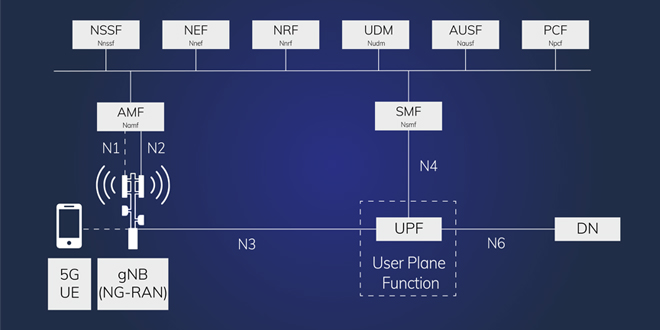The 5G Core Network Architecture, also known as the 5GC, serves as the backbone of 5G communication systems. It is a fundamental component that enables the delivery of advanced services and applications in the 5G ecosystem. The architecture of the 5G Core Network is designed to be flexible, scalable, and capable of meeting the diverse requirements of modern telecommunications.
The 3GPP (3rd Generation Partnership Project) is really important for making the 5G Core Network Architecture. Here’s why:
- Making Rules: The 3GPP sets the rules for how mobile technology, like 5G, should work worldwide. They decide how everything in the 5G system should talk to each other. This helps different companies and networks work together smoothly, making sure your phone can connect wherever you are.
- Building Blocks: The 3GPP’s rules encourage breaking down the 5G network into smaller parts that can talk to each other easily. This makes the network more flexible, scalable, and easier for companies to manage.
The 3GPP decides how key parts of the 5G network work, like:
- Setting up and ending calls and data connections between devices.
- Moving calls and data smoothly as you move around.
- Keeping your calls and data safe from hackers.
By giving clear rules and guidelines, the 3GPP helps make sure the 5G network is strong and ready for all the cool things it can do.
Overview of 5G Core Network Architecture
The 5G Core Network Architecture comprises various network functions and elements, each serving specific roles in facilitating communication between users, devices, and applications. Unlike its predecessors, the 5G Core Network is based on a service-based architecture, which emphasizes modularity, flexibility, and efficiency.

5G Core Network Architecture
Key Functions of the 5G Core Network
- User Plane Function (UPF): The UPF handles the data forwarding and packet routing functions within the 5G network. It is responsible for the efficient transmission of user data packets between the user equipment (UE) and external networks or services. The UPF ensures low latency, high throughput, and reliable data delivery, making it essential for supporting bandwidth-intensive applications such as streaming, gaming, and virtual reality.
- Control Plane Function (CPF): The CPF manages signaling and control functions within the 5G network, including mobility management, session establishment, and authentication. It communicates with the UE and other network functions to establish and maintain connections, manage mobility events, and enforce network policies. The CPF plays a crucial role in optimizing network resources, ensuring quality of service (QoS), and enabling seamless handovers between different network cells.
- Session Management Function (SMF): The SMF is responsible for managing user sessions and data flows within the 5G network. It establishes and maintains context information for active sessions, including user identities, QoS requirements, and session states. The SMF coordinates with other network functions to allocate resources, enforce policies, and optimize session performance based on dynamic traffic conditions and user demands.
- Access and Mobility Management Function (AMF): The AMF manages access and mobility-related functions, including registration, authentication, and handover procedures. It authenticates users, authorizes access to network services, and manages mobility events such as handovers between different access technologies or network slices. The AMF ensures seamless connectivity for users moving between different network areas or switching between cellular and non-cellular access technologies.
- Policy Control Function (PCF): The PCF is responsible for enforcing network policies and service-level agreements (SLAs) within the 5G network. It dynamically allocates resources, applies QoS rules, and enforces traffic management policies based on user profiles, service requirements, and network conditions. The PCF plays a crucial role in optimizing resource utilization, prioritizing critical traffic, and ensuring fair distribution of network resources among different users and applications.
- Authentication Server Function (AUSF): The AUSF authenticates users and devices accessing the 5G network, verifying their identities and credentials. It securely stores authentication information, such as user identities, passwords, and cryptographic keys, and validates user requests for network access. The AUSF ensures the integrity and security of the authentication process, protecting against unauthorized access and identity theft.
- Unified Data Management (UDM) Function: The UDM manages user identity and subscription information within the 5G network. It stores user profiles, service subscriptions, and authentication credentials, enabling seamless access to network services and applications. The UDM facilitates personalized services, user authentication, and identity management across different network functions and domains.
3. Network Slicing
Network slicing emerges as a pivotal feature of the 5G Core Network Architecture, enabling operators to partition the network into distinct virtual slices, each customized for specific use cases or service demands. This facilitates simultaneous support for diverse applications with varying performance, latency, and bandwidth requirements while ensuring isolation and security between slices.
4. Cloud-Native Deployment
Embracing cloud-native principles, the 5G Core Network Architecture leverages virtualization, containerization, and microservices architectures to achieve heightened flexibility, scalability, and efficiency. By deploying network functions as lightweight, independently scalable containers, operators can dynamically allocate resources, optimize performance, and rapidly deploy new services to meet evolving demands.
5. Network Function Virtualization (NFV)
NFV serves as another crucial element of the 5G Core Network Architecture, enabling the virtualization of network functions traditionally implemented as proprietary hardware appliances. By decoupling software from hardware, NFV reduces costs, increases agility, and accelerates innovation, allowing operators to deploy and scale network functions more efficiently.
In essence, the 5G Core Network Architecture heralds a paradigm shift in wireless network design, leveraging service-based principles, cloud-native technologies, and virtualization to deliver a more adaptable, scalable, and efficient network infrastructure capable of supporting a myriad of applications and services.
These are just some of the key functions within the 5G Core Network Architecture. Additionally, the architecture may include other network functions and elements, such as the Network Exposure Function (NEF), the Network Repository Function (NRF), and the Network Slice Selection Function (NSSF), each serving specific roles in enabling advanced features and capabilities of 5G networks.
1. Network Exposure Function (NEF)
Role: NEF serves as a pivotal element within the 5G Core Network, enabling controlled access to network services and capabilities for authorized third-party applications, services, and service providers. It acts as a gateway, exposing network capabilities through standardized Application Programming Interfaces (APIs) to external entities.
Functionality:
- API Management: NEF manages the exposure of network functions and capabilities through standardized APIs, ensuring secure and controlled access to network resources.
- Policy Enforcement: NEF enforces policies to regulate access to network functions, ensuring compliance with security and privacy requirements.
- Service Orchestration: NEF facilitates the orchestration of network resources and services, allowing third-party applications to interact with the network dynamically.
- Service Discovery: NEF provides mechanisms for discovering available network services and capabilities, enabling seamless integration with external applications and services.
2. Network Repository Function (NRF)
Role: NRF serves as a central repository within the 5G Core Network, storing and disseminating information related to network function availability and characteristics. It enables network functions to discover and communicate with each other dynamically.
Functionality:
- Function Discovery: NRF maintains a registry of available network functions, including their capabilities, locations, and operational states, allowing network functions to discover and interact with each other as needed.
- Dynamic Routing: NRF facilitates dynamic routing of service requests to appropriate network functions based on factors such as service requirements, network conditions, and resource availability.
- Load Balancing: NRF distributes service requests across multiple instances of network functions to optimize resource utilization and ensure high availability and performance.
- Fault Tolerance: NRF monitors the health and availability of network functions, automatically rerouting service requests in case of failures or disruptions to maintain service continuity.
3. Network Slice Selection Function (NSSF)
Role: NSSF plays a crucial role in network slicing, facilitating the selection and instantiation of network slices tailored to specific service requirements and user preferences. It enables dynamic creation, allocation, and management of network slices within the 5G Core Network.
Functionality:
- Slice Selection: NSSF selects appropriate network slices based on service requirements, user preferences, and network conditions, ensuring optimal resource allocation and performance.
- Slice Instance Management: NSSF oversees the instantiation and lifecycle management of network slices, including provisioning, scaling, and decommissioning, to accommodate changing service demands.
- QoS Enforcement: NSSF enforces Quality of Service (QoS) policies and SLAs within network slices, ensuring that service-level objectives are met and maintained.
- Inter-Slice Coordination: NSSF facilitates coordination and interaction between different network slices, enabling seamless handovers and interoperability across diverse service domains.
In summary, NEF, NRF, and NSSF are essential components of the 5G Core Network Architecture, playing distinct yet complementary roles in enabling dynamic service orchestration, resource management, and network slicing. Together, they empower operators to deliver a wide range of innovative services and applications while ensuring efficient utilization of network resources and adherence to service-level agreements.
Overall, the 5G Core Network Architecture plays a crucial role in realizing the full potential of 5G technology, enabling high-speed, low-latency, and reliable communication services for users and applications worldwide.





